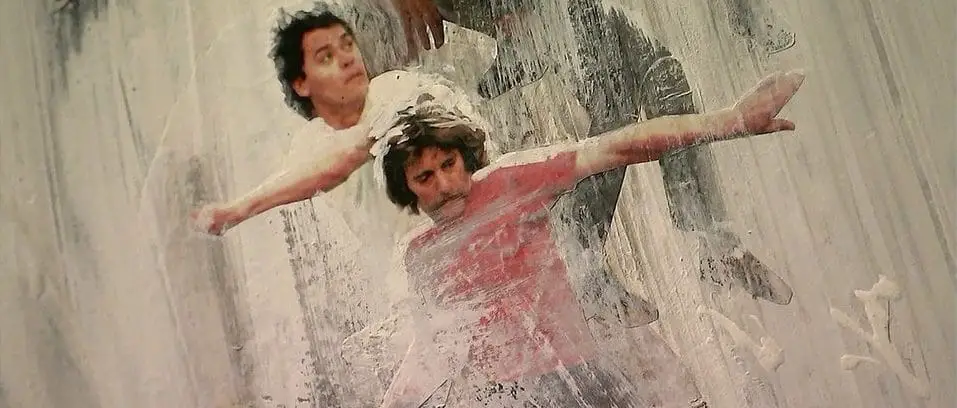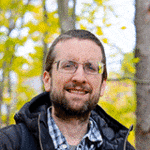A recent exhibition by the New Tretyakov Gallery combined works by artists who were not shown or who were banned during the Soviet era with images from Andrei Tarkovsky’s films and sets. Tarkovsky’s films, such as Solaris and Stalker, have an international cult following and were known for breaking the bounds of what could usually be seen on Soviet screens with their tales of dystopia and loneliness.
The report below from Russia’s usually conservative Pervyi Kanal is interesting not only for the extensive look at the exhibit but also for how it describes the exhibit and its related history. Most of the discussion would go against views held by more conservative members of Russian society. The 1990s are mentioned as a time of unparalleled artistic freedom and Soviet times are discussed as having been potentially dangerous for artist. Artists who defy authority are praised. Even the fact that clairvoyance is extensively discussed is interesting, as the Russian Orthodox Church generally frowns on any mention of the supernatural.
The piece ends by saying that the New Tretyakov, in central Moscow, plans to put on more shows like this one.
The full video is presented below as is a full transcript in side-by-side translation.
| В Новой Третьяковке оживают образы Андрея Тарковского | In the New Tretyakov Gallery, Andrei Tarkovsky’s Images Come to Life |
| Эти выходные — последняя возможность увидеть выставку «Свободный полет» в Новой Третьяковке. Это не просто экспозиция — в ней буквально оживают образы гениального Андрея Тарковского и других художников, которые творили, несмотря ни на что. | This weekend is the last opportunity to see Free Flight, an exhibition at the New Tretyakov Gallery. This is not just an exposition – here, images literally come to life, including those of the brilliant Andrei Tarkovsky and other artists who created, no matter what might have stood in their way. |
| Неведомые материи внезапно вторгаются в жизнь людей и повсюду хаос. Из-под земли или из космоса. А может, вообще, из потустороннего мира. Даже сам художник Петр Беленок, родившийся в деревне под Чернобылем, не мог объяснить свои картины-видения. | Unfathomable matters suddenly invade people’s lives, generating chaos everywhere. They come from underground, from space, or, maybe, from an entirely different world. Peter Belenok, an artist born in a village near Chernobyl, could not even himself explain his vision-like paintings. |
| Непонятный яркий луч бьет в небо, и люди убегают от него в панике. Здесь предчувствие художника просто поразительно, ведь он изображает катастрофу на Чернобыльской атомной станции, которая произойдет только через восемь лет. А еще через четыре года будет сделана эта фотография в разрушенном машинном зале станции: искореженные турбины, куски металла и тот самый белый свет, пробивающийся через отверстие в саркофаге. Фильм Андрея Тарковского «Сталкер», тоже случившийся в реальности. Фото со съемок «Сталкера» удивительно перекликаются с видами взорвавшегося реактора. А Петр Беленок использует киноприем — комбинированная съемка — вырезает снимки людей из спортивных газет. Отсюда столько эмоций. | An incomprehensible bright beam bursts from the sky and people run from it in panic. Here the artist’s premonition is simply amazing, because he portrays the disaster at the Chernobyl Nuclear Power Plant, which happened only eight years later. Four years after the accident, this photograph was taken in the station’s destroyed machine room: twisted turbines, pieces of metal and the same white light breaking through an opening in the sarcophagus. Andrei Tarkovsky’s film Stalker also comes to life. Photos from the set of Stalker surprisingly call to mind an image of the exploding reactor. And Petr Belenok uses cinematic techniques through collage using images of people cut from sports newspapers. From here come so many emotions. |
| И пророческий фильм про Зону отчуждения, и эти картины созданы в одно время, с одинаковым предвидением неизбежной катастрофы — и духовной, и техногенной. | The prophetic film about the Exclusion Zone and these pictures were both created at the same time, with the same anticipation of an inevitable catastrophe – both spiritual and technological. |
| «Ощущение вообще какого-то космического ужаса и одиночества человека в космосе. Тарковский ведь снял «Сталкер» за девять лет до этой катастрофы. Они — художники. И у них было какое-то великое предощущение, предвидение этого события» , — сказала куратор, автор проекта «Свободный полет» Полина Лобачевская. | “It’s the feeling of some kind of cosmic horror and human loneliness in the universe. Tarkovsky shot Stalker just nine years before the disaster. They are artists. And they had some great foreboding, some great foresight of this event,” said Polina Lobachevskaya, curator and author of the Free Flight exposition. |
| Экраны с кадрами из «Андрея Рублева» словно парят в невесомости. Фильм, над которым чиновники в свое время просто издевались, сегодня для нас шедевр изобразительного искусства. | Screens showing stills from Andrei Rublev seem to float in zero gravity. The film, which officials simply mocked at the time, we today consider a masterpiece. |
| Как и герои «Соляриса», собравшие на станции шедевры мирового искусства, устроители выставки взяли в «Свободный полет» лишь избранные работы советского андеграунда. Анатолия Зверева называют русским Матиссом и Пикассо. Почти слепой Владимир Яковлев творил в больнице для душевнобольных. | Like the heroes of Solaris, who gathered masterpieces of world art in a space station, the organizers of the exhibition took only selected works from the Soviet underground for Free Flight. Anatoly Zverev is called the Russian Matisse and Picasso. Vladimir Yakovlev, almost blind, worked while in an asylum. |
| Сын испанского политэмигранта Франциско Инфанте начал рисовать космическое будущее человечества, энергию Вселенной. Сегодня его сын Платон Инфанте — автор этой разумной планеты Солярис — использует не кисти и краски, а современные технологии. | The son of the Spanish political refugee Francisco Infante began to paint the cosmic future of mankind, the energy of the universe. Today, his son Platon Infante – the author of this well thought out planet Solaris – does not use brushes and paints, but modern technology. |
| Выставки, подобные этой, теперь будут проходить здесь, на новой площадке Третьяковки на Крымском валу, в бывших залах ЦДХ. | Exhibitions such as this will now be held here, at the new Tretyakov space on Krymsky Val, in the former halls of the Central House of Artists. |
| «Мы будем перекидывать мостик к тому, что происходило в этом здании в 1989-м, 1990-м и 1991-м годах, когда были выставки, которые открывали для нас новый, неизведанный мир современного искусства», — сказала генеральный директор Государственной Третьяковской галереи Зельфира Трегулова. | “We will cast connections to what occurred in this building in 1989, 1990 and 1991, when there were exhibitions that opened for us a new, uncharted world of contemporary art,” said State Tretyakov Gallery General Director Zelfira Tregulova. |
| Совместный проект Третьяковки с Музеем AZ совершенно по-новому раскрывает и работы запрещенных советских художников, и фильмы гениального Тарковского. Подчеркивая, что творчество в любые времена — это и поступок, и предвидение, и территория свободы, которую невозможно отнять. | This joint project between the Tretyakov Gallery and AZ Museum shows the works of banned Soviet artists and the films of the genius Tarkovsky in a completely new way. Emphasizing that creativity at any time is an act, a vision, and an area of freedom that cannot be taken away. |







